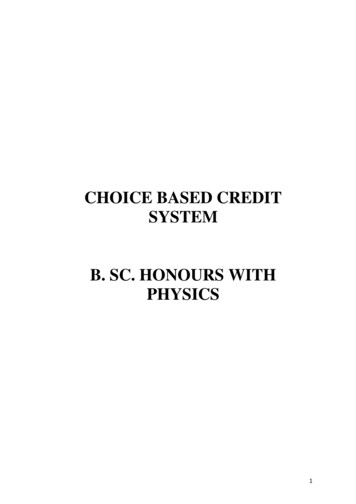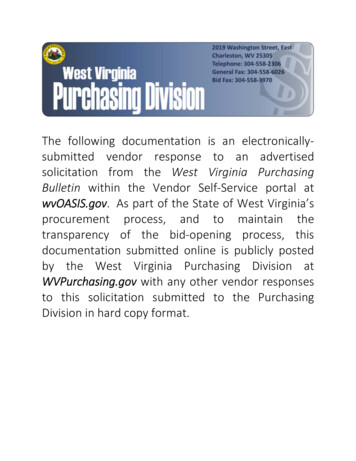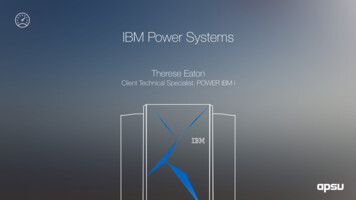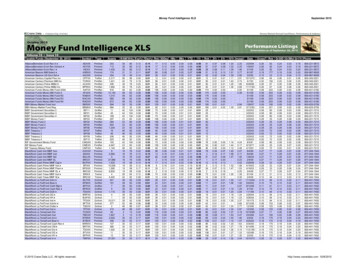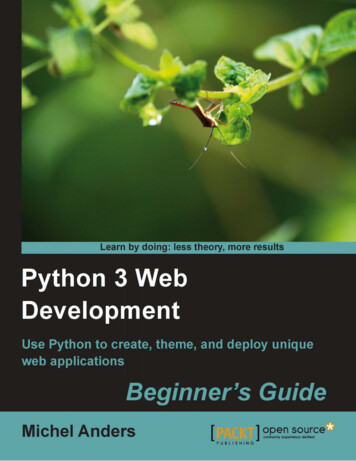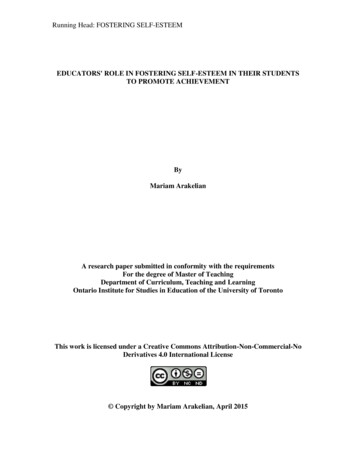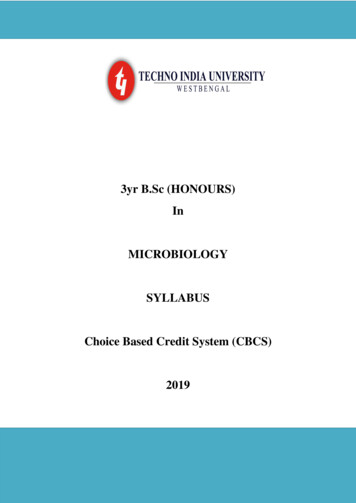
Transcription
3yr B.Sc (HONOURS)InMICROBIOLOGYSYLLABUSChoice Based Credit System (CBCS)20191
EM 4, Sector V, Salt Lake, Kolkata-700091, West Bengal, IndiaPhone: 91 9836544416/17/18/19, Fax: 91 33 2357 1097Semester Wise Microbiology Honours HMB-T1C1TIU-HMB-P1C1TIU-HMB-T1C3TIU-HMB-P1C32T 2P(2X4 2X2 HMB-P1C42T 2P(2X4 2X2 HMB-P2C7TIU-HMB-T2C9TIU-HMB-P2C93T 3P(3X4 3X2 HMB-P2C8TIU-HMB-T2C10TIU-HMB-P2C103T 3P(3X4 3X2 IU-HMB-P3C132T 2P(2X4 2X2 IU-HMB-P3C142T 2P(2X4 2X2 12Credits)TIU-UCH-T1G1TIU-UCH-P1G11T 1P (1X4 1X2 6Credits)TIU-UCH-T1G2TIU-UCH-P1G21T 1P(1X4 1X2 6Credits)TIU-UCS-T2G1TIU-UCS-P2G11T 1P (1X4 1X2 6Credits)TIU-UCS-T2G2TIU-UCS-P2G21T 1P (1X4 1X2 MB-P3D3TIU-HMB-T3D5TIU-HMB-P3D52T 2P Any two:(2X4 2X2 HMB-P3D4TIU-HMB-T3D6TIU-HMB-P3D62T 2P Any two:(2X4 2X2 12Credits)24 Credits24 cementElectiveCoursesCASDTotal 140 CreditsTIU-UCE-T1051T 0P (2 Credits)(language)TIU-UES-T1061T 0P (2 Credits)(EnvironmentalScience)20 Credits20 -P2S31T 0P (1X2 2Credits)Any 41T 0P(1X2 2Credits)Any one26 Credits26 CreditsWWW.TECHNOINDIAUNIVERSITY.AC.IN2
EM 4, Sector V, Salt Lake, Kolkata-700091, West Bengal, IndiaPhone: 91 9836544416/17/18/19, Fax: 91 33 2357 1097WWW.TECHNOINDIAUNIVERSITY.AC.IN3
EM 4, Sector V, Salt Lake, Kolkata-700091, West Bengal, IndiaPhone: 91 9836544416/17/18/19, Fax: 91 33 2357 1097WWW.TECHNOINDIAUNIVERSITY.AC.IN4
EM 4, Sector V, Salt Lake, Kolkata-700091, West Bengal, IndiaPhone: 91 9836544416/17/18/19, Fax: 91 33 2357 1097CORE COURSESSEMESTER –2TIU-HMB-T102: BIOCHEMISTRY (THEORY)TOTAL HOURS: 60CREDITS: 4Unit 1 Bioenergetics No. of Hours: 8First and second laws of Thermodynamics. Definitions ofGibb’s Free Energy, enthalpy,and Entropy and mathematical relationship among them, Standard freeenergy change and equilibrium constant Coupled reactions and additive nature of standard free energychange, Energy rich compounds: Phosphoenolpyruvate, 1,3- Bisphosphoglycerate, Thioesters, ATPUnit 2 Carbohydrates No. of Hours: 12 Families of monosaccharides: aldoses and ketoses,trioses, tetroses, pentoses, and hexoses. Stereo isomerism of monosaccharides, epimers, Mutarotationand anomers of glucose.Furanose and pyranose forms of glucose and fructose, Haworth projectionformulae for glucose; chair and boat forms of glucose, Sugar derivatives, glucosamine, galactosamine,muramic acid, N- acetyl neuraminic acid, Disaccharides; concept of reducing and non-reducingsugars, occurrence and Haworth projections of maltose, lactose, and sucrose, Polysaccharides, storagepolysaccharides, starch and glycogen. Structural Polysaccharides, cellulose, peptidoglycan and chitinUnit 3 Lipids No. of Hours: 12 Definition and major classes of storage and structural lipids.Storage lipids.Fatty acids structure and functions.Essential fatty acids.Triacylglycerols structure,functions and properties. Saponification Structural lipids.Phosphoglycerides: Building blocks, Generalstructure, functions and properties. Structure of phosphatidylethanolamine and phosphatidylcholine,Sphingolipids: building blocks, structure of sphingosine, ceramide. Special mention ofsphingomyelins, cerebrosides and gangliosides Lipid functions: cell signals, cofactors, prostaglandins,Introduction of lipid micelles, monolayers, bilayersUnit 4 Proteins No. of Hours: 12Functions of proteins, Primary structures of proteins: Aminoacids, the building blocks of proteins. General formula of amino acid and concept of zwitterion.Titration curve of amino acid and its Significance, Classification, biochemical structure and notationof standard protein amino acids Ninhydrinreaction.Natural modifications of amino acids in proteinshydrolysine, cystine and hydroxyproline, Non protein amino acids: Gramicidin, beta-alanine, Dalanine and D- glutamic acid Oligopeptides: Structure and functions of naturally occurring glutathioneand insulin and synthetic aspartame, Secondary structure of proteins: Peptide unit and its salientfeatures. The alpha helix, the beta pleated sheet and their occurrence in proteins, Tertiary andquaternary structures of proteins. Forces holding the polypeptide together. Human haemoglobinstructure, Quaternary structures of proteinsWWW.TECHNOINDIAUNIVERSITY.AC.IN5
EM 4, Sector V, Salt Lake, Kolkata-700091, West Bengal, IndiaPhone: 91 9836544416/17/18/19, Fax: 91 33 2357 1097Unit 5. EnzymesNo. of Hours: 12Structure of enzyme: Apoenzyme and cofactors, prosthetic group-TPP, coenzyme NAD,metalcofactors, Classification of enzymes, Mechanism of action of enzymes: active site, transition statecomplex and activation energy. Lock and key hypothesis, and Induced Fit hypothesis. Significance ofhyperbolic, double reciprocal plots of enzyme activity, Km, and allosteric mechanism Definitions ofterms – enzyme unit, specific activity and turnover number, Multienzymecomplex : pyruvatedehydrogenase; isozyme: lactate dehydrogenase, Effect of pH and temperature on enzyme activity.Enzyme inhibition: competitive- sulfa drugs; non-competitive-heavy metal saltsUnit 6. Vitamins No. of Hours: 4Classification and characteristics with suitable examples, sources and importanceTIU-HMB-L102: BIOCHEMISTRY (PRATICAL)TOTAL HOURS: 60 CREDITS: 21. Properties of water, Concept of pH and buffers, preparationof buffers and Numerical problems to explain the concepts2. Numerical problems on calculations of Standard Free Energy Change and Equilibrium constant3. Standard Free Energy Change of coupled reactions4. Qualitative/Quantitative tests for carbohydrates, reducing sugars, non reducing sugars5. Qualitative/Quantitative tests for lipids and proteins6. Study of protein secondary and tertiary structures with the help of models7. Study of enzyme kinetics – calculation of Vmax , Km, Kcat values8. Study effect of temperature, pH and Heavy metals on enzyme activity9. Estimation of any one vitaminSUGGESTED READING1. Campbell, MK (2012) Biochemistry, 7th ed., Published by Cengage Learning2. Campbell, PN and Smith AD (2011) Biochemistry Illustrated, 4th ed., Published by ChurchillLivingstone3. Tymoczko JL, Berg JM and Stryer L (2012) Biochemistry: A short course, 2nd ed., W.H.FreemanWWW.TECHNOINDIAUNIVERSITY.AC.IN6
EM 4, Sector V, Salt Lake, Kolkata-700091, West Bengal, IndiaPhone: 91 9836544416/17/18/19, Fax: 91 33 2357 10974. Berg JM, Tymoczko JL and Stryer L (2011) Biochemistry, W.H.Freeman and Company5. Nelson DL and Cox MM (2008) Lehninger Principles of Biochemistry, 5th Edition., W.H.Freeman and Company,6. Willey MJ, Sherwood, LM &Woolverton C J (2013) Prescott, Harley and Klein’s Microbiology by.9th Ed., McGrawHill7. Voet,D. and Voet J.G (2004) Biochemistry 3rd edition, John Wiley and Sons,TIU-HMB-T104: CELL BIOLOGY (THEORY)TOTAL HOURS: 60 CREDITS: 4Unit 1 Structure and organization of Cell No. of Hours: 12Cell Organization – Eukaryotic (Plant and animal cells) and prokaryotic Plasma membrane: Structureand transport of small moleculesCell Wall: Eukaryotic cell wall, Extra cellular matrix and cell matrix interactions, Cell-CellInteractions - adhesion junctions, tight junctions, gap junctions, and plasmodesmata (only structuralaspects) Mitochondria, chloroplasts and peroxisomesCytoskeleton: Structure and organization of actin filaments, association of actin filaments with plasmamembrane, cell surface protrusions, intermediate filaments, microtubulesUnit 2 NucleusNo. of Hours: 4Nuclear envelope, nuclear pore complex and nuclear laminaChromatin – Molecular organizationNucleolusUnit 3 Protein Sorting and TransportNo. of Hours: 12Ribosomes, Endoplasmic Reticulum – Structure, targeting and insertion of proteins in the ER, proteinfolding, processing and quality control in ER, smooth ER and lipid synthesis, export of proteins andlipids Golgi Apparatus – Organization, protein glycosylation, protein sorting and export from GolgiApparatus LysosomesUnit 4 Cell SignallingNo. of Hours: 8Signalling molecules and their receptorsFunction of cell surface receptorsPathways of intra-cellular receptors – Cyclic AMP pathway, cyclic GMP and MAP kinase pathwayUnit5 Cell Cell Death and Cell Renewal CycleNo. of Hours: 12Eukaryotic cell cycle and its regulation, Mitosis and MeiosisDevelopment of cancer, causes and typesWWW.TECHNOINDIAUNIVERSITY.AC.IN7
EM 4, Sector V, Salt Lake, Kolkata-700091, West Bengal, IndiaPhone: 91 9836544416/17/18/19, Fax: 91 33 2357 1097Programmed cell deathStem cellsEmbryonic stem cell, induced pleuripotent stem cellsTIU-HMB-L104: CELL BIOLOGY (PRACTICAL)TOTAL HOURS: 60 CREDITS: 21. Study a representative plant and animal cell by microscopy.2. Study of the structure of cell organelles through electron micrographs3. Cytochemical staining of DNA – Feulgen4. Demonstration of the presence of mitochondria in striated muscle cells/ cheek epithelial cell usingvital stain Janus Green B5. Study of polyploidy in Onion root tip by colchicine treatment.6. Identification and study of cancer cells by photomicrographs.7. Study of different stages of Mitosis.8. Study of different stages of Meiosis.SUGGESTED READING1. Hardin J, Bertoni G and Kleinsmith LJ. (2010). Becker’s World of the Cell.8th edition. Pearson.2. Karp G. (2010) Cell and Molecular Biology: Concepts and Experiments. 6th edition.John Wiley &Sons.Inc.3. De Robertis, EDP and De Robertis EMF.(2006). Cell and Molecular Biology.8th edition.LipincottWilliams and Wilkins, Philadelphia.4. Cooper, G.M. and Hausman, R.E. (2009). The Cell: A Molecular Approach. 5th Edition.ASMPress & Sunderland, Washington, D.C.; Sinauer Associates, MA.WWW.TECHNOINDIAUNIVERSITY.AC.IN8
6. Identification and study of cancer cells by photomicrographs. 7. Study of different stages of Mitosis. 8. Study of different stages of Meiosis. SUGGESTED READING 1. Hardin J, Bertoni G and Kleinsmith LJ. (2010). Becker’s World of the Cell.8th edition. Pearson. 2. Karp G. (2010) Cell and Molecular
